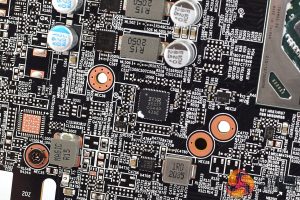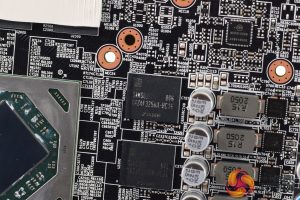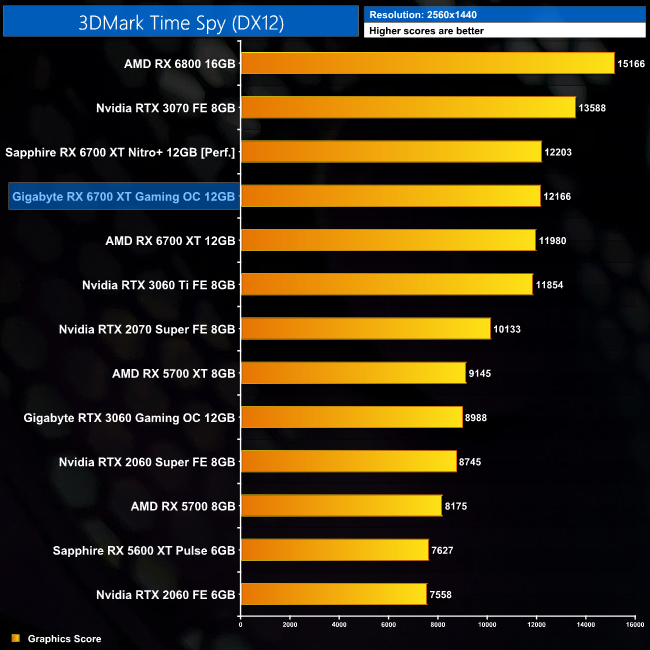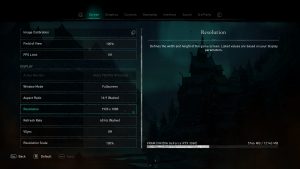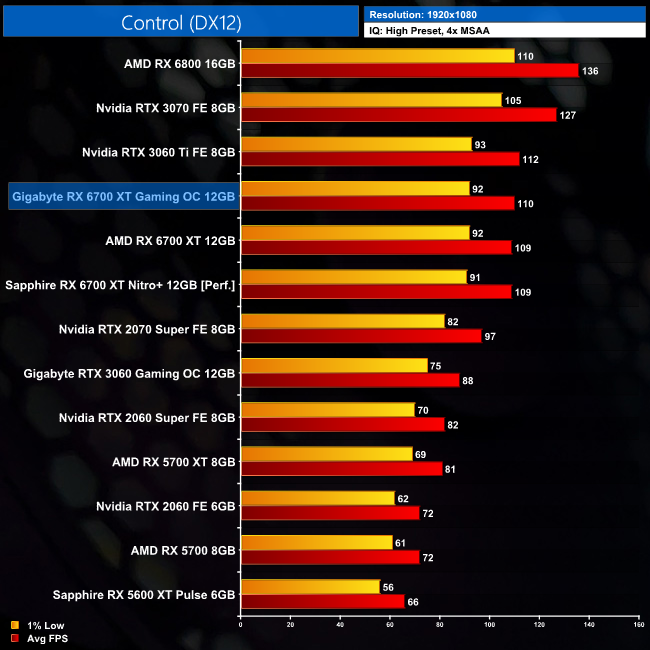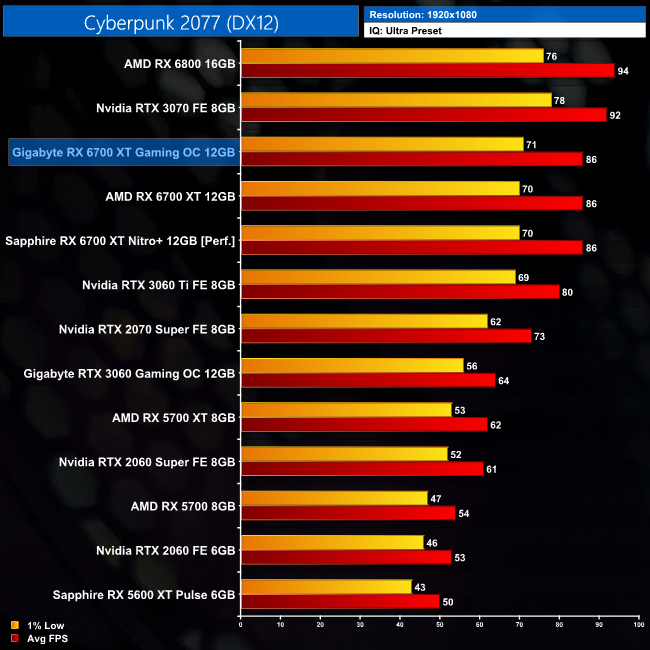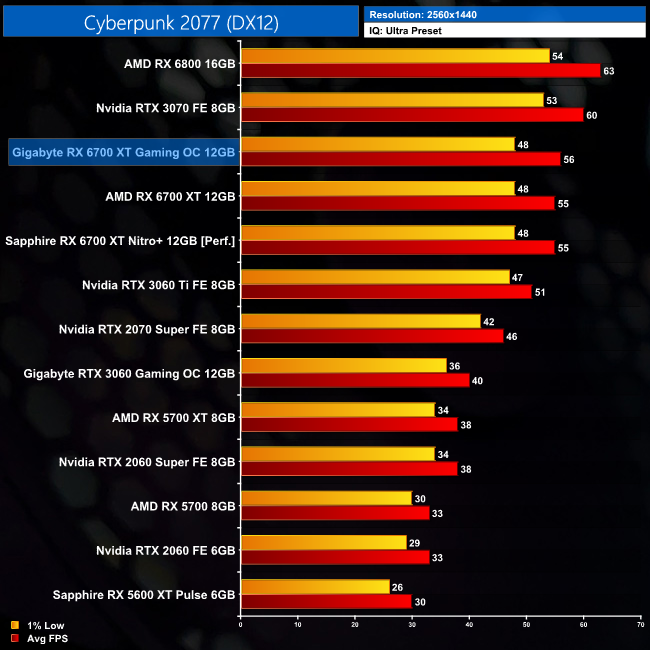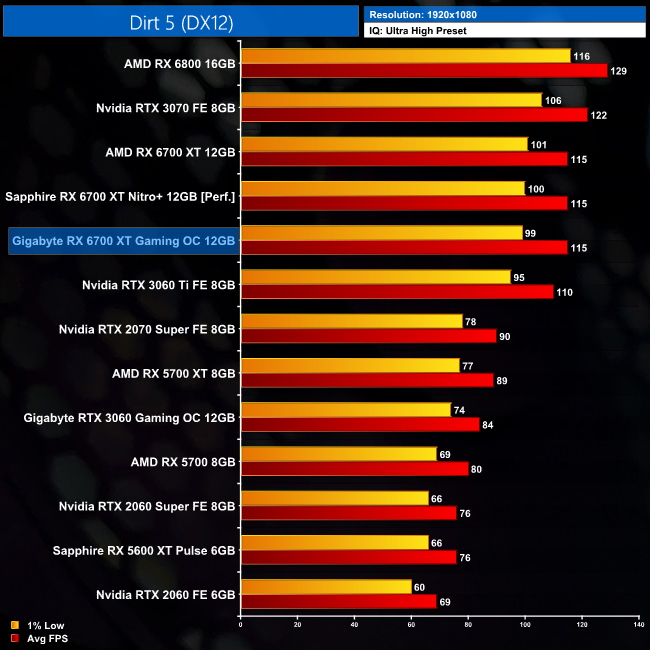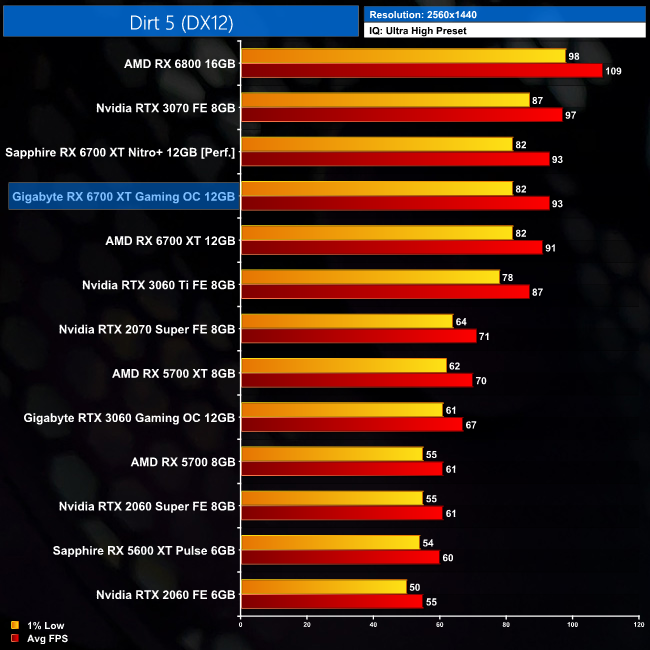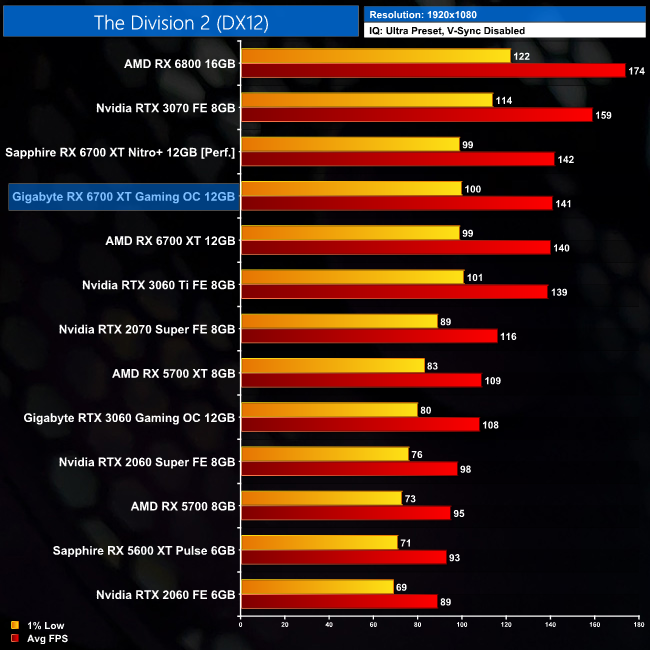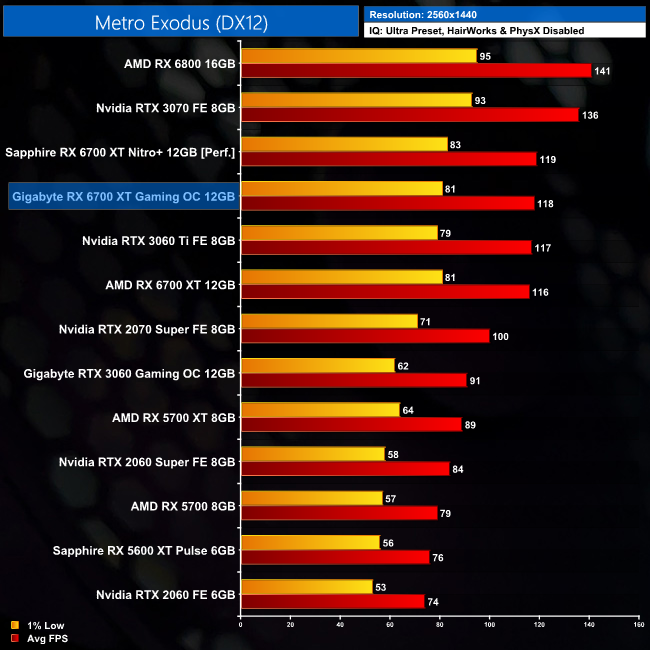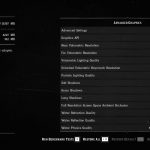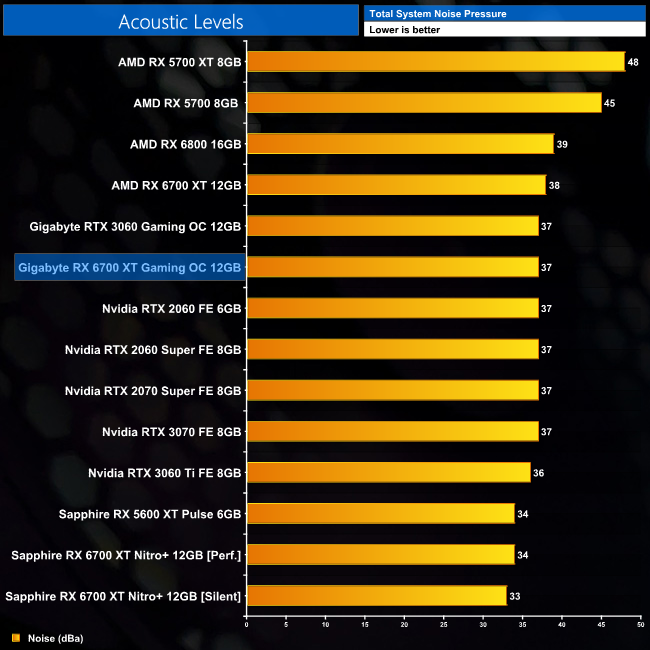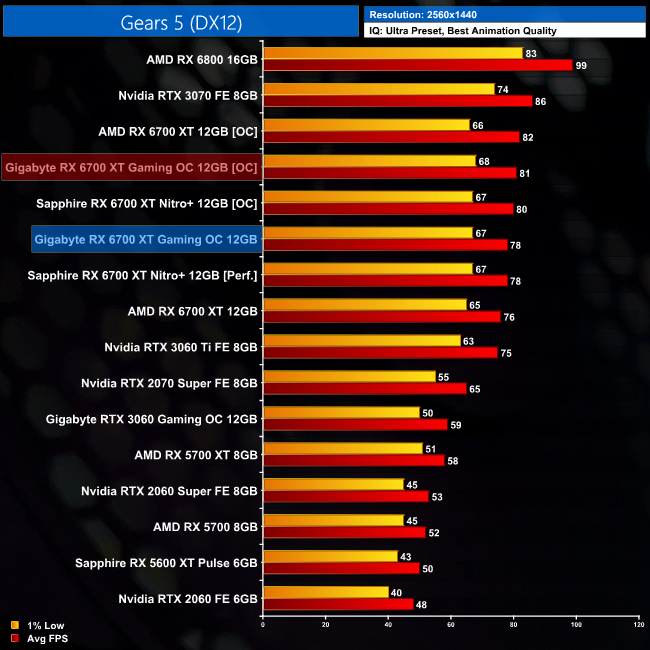
Today we are back with our third RX 6700 XT review, following on from Sapphire's Nitro+ card and AMD's reference design. The card in question is Gigabyte's RX 6700 XT Gaming OC, featuring the company's Windforce 3X cooler, a factory overclocked core and a full-length metal backplate. Is this a 6700 XT to consider, or are there better options?
We've reviewed several of Gigabyte's current-generation graphics cards, including the RX 6900 XT, RTX 3070 and RTX 3060 models. All share the same overall appearance, with just a few differences on show when looking at the internal heatsink design. That applies to the RX 6700 XT Gaming OC as well, though one thing to note right away is that it doesn't support dual-BIOS, which is something found on the RTX 3070 and RX 6900 XT models.
| RX 6900 XT | RX 6800 XT | RX 6800 | RX 6700 XT | RX 5700 XT | |
| Architecture | RDNA 2 | RDNA 2 | RDNA 2 | RDNA 2 | RDNA |
| Manufacturing Process | 7nm | 7nm | 7nm | 7nm | 7nm |
| Transistor Count | 26.8 billion | 26.8 billion | 26.8 billion | 17.2 billion | 10.3 billion |
| Die Size | 519 mm² | 519 mm² | 519 mm² | 336 mm² | 251 mm² |
| Ray Accelerators | 80 | 72 | 60 | 40 | n/a |
| Compute Units | 80 | 72 | 60 | 40 | 40 |
| Stream Processors | 5120 | 4608 | 3840 | 2560 | 2560 |
| Game GPU Clock | Up to 2015MHz | Up to 2015MHz | Up to 1815MHz | Up to 2424MHz | Up to 1755MHz |
| Boost GPU Clock | Up to 2250MHz | Up to 2250MHz | Up to 2105MHz | Up to 2581MHz | Up to 1905MHz |
| Peak SP Performance | Up to 23.04 TFLOPS | Up to 20.74 TFLOPS | Up to 16.17 TFLOPS | Up to 13.21 TFLOPS | Up to 9.75 TFLOPS |
| Peak Half Precision Performance | Up to 46.08 TFLOPS | Up to 41.47 TFLOPS | Up to 32.33 TFLOPS | Up to 26.43 TFLOPS | Up to 19.5 TFLOPS |
| Peak Texture Fill-Rate | Up to 720 GT/s | Up to 648.0 GT/s | Up to 505.2 GT/s | Up to 413.0 GT/s | Up to 304.8 GT/s |
| ROPs | 128 | 128 | 96 | 64 | 64 |
| Peak Pixel Fill-Rate | Up to 288.0 GP/s | Up to 288.0 GP/s | Up to 202.1 GP/s | Up to 165.2 GP/s | Up to 121.9 GP/s |
| AMD Infinity Cache | 128MB | 128MB | 128MB | 96MB | n/a |
| Memory | 16GB GDDR6 | 16GB GDDR6 | 16GB GDDR6 | 12GB GDDR6 | 8GB GDDR6 |
| Memory Bandwidth | 512 GB/s | 512 GB/s | 512 GB/s | 384 GB/s | 448 GB/s |
| Memory Interface | 256-bit | 256-bit | 256-bit | 192-bit | 256-bit |
| Board Power | 300W | 300W | 250W | 230W | 225W |
RX 6700 XT is built using the Navi 22 GPU, a physically smaller die than Navi 21, measuring 336 mm². It houses 40 Compute Units (CUs), with 64 stream processors per CU, giving a total of 2560. RX 6700 XT features a fully populated Navi 22 GPU, but we can expect cut-down versions to appear with the RX 6700, and potentially RX 6600 XT if that comes to market.
RDNA 2 houses one ray accelerator per CU, so there's a total of 40 with the RX 6700 XT. Four texture units per CU gives a total of 160, while there's also 64 ROPs. The reference 6700 XT has a rated game clock of 2424MHz, but Gigabyte has increased this to 2514MHz.
As for the memory configuration, AMD has opted to use a 192-bit memory interface paired with 12GB of GDDR6 memory. Using 16Gbps modules, total memory bandwidth hits 384 GB/s, which is lower than its predecessor, the RX 5700 XT. RDNA 2 GPUs, however, have the benefit of AMD's Infinity Cache, with a 96MB cache used here.
Lastly, reference total board power (TBP) is rated at 230W. Gigabyte hasn't confirmed that the TBP has increased with the Gaming OC, but we would expect that to be the case. This is something we test later in the review.
The Gigabyte RX 6700 XT Gaming OC arrives in a black box, adorned with Gigabyte's robotic eye logo on the front. On the back, various key features of the graphics card are highlighted, including the triple fan setup and direct touch heatpipes.
Inside, the only accessory is this quick start guide.
As for the graphics card itself, as we alluded to on the previous page, it is a design we are now very familiar with. The Gaming OC uses a plastic shroud that’s mostly black but has some grey sections so it isn’t completely monotone. It’s very stealthy all-round with no colour on the card at all.
In terms of the fans, Gigabyte uses three 80mm fans, and as with all of its graphics card designs from the last couple of years, the central fan spins in reverse relative to the outer two, which Gigabyte claims helps to reduce airflow turbulence from the fans.
Dimensions are listed at 281 x 115 x 49mm, so it's not a massive card but modern standards, but it's hardly mini ITX-friendly.
The backplate is a full-length metal design, with the Gigabyte logo printed in white. There is a tiny cut-out in the metal towards the end of the card, which Gigabyte calls ‘screen cooling', and it's designed to allow air to pass directly through the heatsink… but given how small the cut-out is, I'm not sure exactly how much it will accomplish!
Elsewhere, we can see power requirements are the same as reference, with 1x 8-pin and 1x 6-pin PCIe connectors. Display outputs consist of 2x HDMI 2.1 and 2x DisplayPort 1.4.
Upon disassembly of the card, we get a good look at the PCB. Gigabyte is using what appears to be a very similar design to the reference card, with an 11-phase power solution that's split with 9 phases for the GPU and 2 phases for the memory. The GPU VRM is controlled by International Rectifier’s IR35217, while the memory controller used is OnSemi’s NCP81022N. Vishay SIC653A and SIC649A MOSFETs are used throughout.
The heatsink is comprised of three fin stacks, connected by a total of 5x 6mm copper heatpipes. Unlike the RX 6900 XT Gaming OC, which uses a copper baseplate, here the heatpipes make direct contact with the GPU die. We can also see a variety of secondary plates used to contact the VRM and memory via thermal pads.
The metal backplate contacts with the PCB thanks to a single, but large, thermal pad right behind the GPU die.
Driver Notes
- All Nvidia GPUs (except RTX 3060) were benchmarked with the 461.40 driver.
- RTX 3060 was benchmarked with the 461.64 driver supplied to press.
- All AMD GPUs (except RX 6700 XT) were benchmarked with the Adrenalin 21.2.2 driver.
- RX 6700 XT was benchmarked with the Adrenalin 20.50 driver supplied to press.
Test System
We test using the a custom built system from PCSpecialist, based on Intel's Comet Lake-S platform. You can read more about it over HERE, and configure your own system from PCSpecialist HERE.
| CPU |
Intel Core i9-10900K
Overclocked to 5.1GHz on all cores |
| Motherboard |
ASUS ROG Maximus XII Hero Wi-Fi
|
| Memory |
Corsair Vengeance DDR4 3600MHz (4 X 8GB)
CL 18-22-22-42
|
| Graphics Card |
Varies
|
| System Drive |
500GB Samsung 970 Evo Plus M.2
|
| Games Drive | 2TB Samsung 860 QVO 2.5″ SSD |
| Chassis | Fractal Meshify S2 Blackout Tempered Glass |
| CPU Cooler |
Corsair H115i RGB Platinum Hydro Series
|
| Power Supply |
Corsair 1200W HX Series Modular 80 Plus Platinum
|
| Operating System |
Windows 10 2004
|
Comparison Graphics Cards List
- Nvidia RTX 3070 FE 8GB
- Nvidia RTX 3060 Ti FE 8GB
- Gigabyte RTX 3060 Gaming OC 12GB
- Nvidia RTX 2070 Super FE 8GB
- Nvidia RTX 2060 Super FE 8GB
- Nvidia RTX 2060 FE 6GB
- AMD RX 6800 16GB
- AMD RX 6700 XT 12GB
- Sapphire RX 6700 XT Nitro+ 12GB
- AMD RX 5700 XT 8GB
- AMD RX 5700 8GB
- Sapphire RX 5600 XT Pulse 6GB
Software and Games List
- 3DMark Fire Strike & Fire Strike Ultra (DX11 Synthetic)
- 3DMark Time Spy (DX12 Synthetic)
- 3DMark Raytracing Feature Test (DXR Synthetic)
- Assassin's Creed Valhalla (DX12)
- Control (DX12)
- Cyberpunk 2077 (DX12)
- Dirt 5 (DX12)
- The Division 2 (DX12)
- F1 2020 (DX12)
- Gears 5 (DX12)
- Hitman 3 (DX12)
- Metro: Exodus (DX12)
- Red Dead Redemption 2 (Vulkan)
- Total War Saga: Troy (DX11)
- Watch Dogs: Legion (DX12)
We run each benchmark/game three times, and present mean averages in our graphs. We use OCAT to measure average frame rates as well as 1% low values across our three runs.
Fire Strike is a showcase DirectX 11 benchmark for modern gaming PCs. Its ambitious real-time graphics are rendered with detail and complexity far beyond other DirectX 11 benchmarks and games. Fire Strike includes two graphics tests, a physics test and a combined test that stresses the CPU and GPU. (UL).
3DMark Time Spy is a DirectX 12 benchmark test for Windows 10 gaming PCs. Time Spy is one of the first DirectX 12 apps to be built the right way from the ground up to fully realize the performance gains that the new API offers. With its pure DirectX 12 engine, which supports new API features like asynchronous compute, explicit multi-adapter, and multi-threading, Time Spy is the ideal test for benchmarking the latest graphics cards. (UL).
Looking first at 3DMark, we can see very small differences between the three RX 6700 XT cards we have tested. The Gaming OC is 2% faster than the reference card in Fire Strike and Time Spy, but just 1% faster in Fire Strike Ultra. Compared to Sapphire's Nitro+, there is effectively no difference between the two across all three benchmarks.
Real-time ray tracing is incredibly demanding. The latest graphics cards have dedicated hardware that’s optimized for ray-tracing. The 3DMark DirectX Raytracing feature test measures the performance of this dedicated hardware. Instead of using traditional rendering techniques, the whole scene is ray-traced and drawn in one pass. The result of the test depends entirely on ray-tracing performance. (UL).
3DMark's DXR feature test paints a difficult picture for the RX 6700 XT, with the Gaming OC barely outperforming Nvidia's RTX 2060. It's 1% faster than the reference 6700 XT, while there's just 0.02FPS separating the Gaming OC and the Nitro+.
Assassin's Creed Valhalla is an action role-playing video game developed by Ubisoft Montreal and published by Ubisoft. It is the twelfth major installment and the twenty-second release in the Assassin's Creed series, and a successor to the 2018's Assassin's Creed Odyssey. The game was released on November 10, 2020, for Microsoft Windows, PlayStation 4, Xbox One, Xbox Series X and Series S, and Stadia, while the PlayStation 5 version was released on November 12. (Wikipedia.)
Engine: AnvilNext 2.0. We test using the Ultra High preset, DX12 API.
Our first game of the day is Assassin's Creed Valhalla. Here, the Gaming OC is an exact match for AMD's reference card at 1440p, while it is a single frame (1%) faster than the Sapphire Nitro+.
Control is an action-adventure video game developed by Remedy Entertainment and published by 505 Games. Control was released on 27 August 2019 for Microsoft Windows, PlayStation 4, and Xbox One. (Wikipedia).
Engine: Northlight Engine. We test using the High preset, with 4x MSAA, DX12 API.
Next is Remedy's Control, a game which clearly favours Nvidia hardware. At 1440p, all three of our RX 6700 XTs average 70FPS, putting them 3% slower than Nvidia's RTX 3060 Ti.
Cyberpunk 2077 is a 2020 action role-playing video game developed and published by CD Projekt. The story takes place in Night City, an open world set in the Cyberpunk universe. Players assume the first-person perspective of a customisable mercenary known as V, who can acquire skills in hacking and machinery with options for melee and ranged combat. Cyberpunk 2077 was released for Microsoft Windows, PlayStation 4, Stadia, and Xbox One on 10 December 2020. (Wikipedia)
Engine: REDengine 4. We test using the Ultra preset, DX12 API.
As for Cyberpunk 2077, this is the only game where the RX 6700 XT couldn't manage 60FPS at 1440p. The Gaming OC hit 56FPS on average, compared to 55FPS for the reference card and Sapphire's Nitro+.
Dirt 5 (stylised as DIRT5) is a racing video game developed and published by Codemasters. It is the fourteenth game in the Colin McRae Rally series and the eighth game to carry the Dirt title. The game was released for Microsoft Windows, PlayStation 4 and Xbox One on 6 November 2020. (Wikipedia).
Engine: Onrush. We test using the Ultra High preset, DX12 API.
Dirt 5 shows a touch more variation in performance than the other titles we have looked at so far, but at 1440p there's still just a 2FPS gap between all three RX 6700 XTs on test.
Tom Clancy's The Division 2 is an online action role-playing video game developed by Massive Entertainment and published by Ubisoft. The sequel to Tom Clancy's The Division (2016), it is set in a near-future Washington, D.C. in the aftermath of a smallpox pandemic, and follows an agent of the Strategic Homeland Division as they try to rebuild the city. (Wikipedia).
Engine: Snowdrop. We test using the Ultra preset, but with V-Sync disabled, DX12 API.
As for The Division 2, at 1440p the Gaming OC hit 92FPS on average, so just a single frame behind the Nitro+, but a couple of frames faster than the AMD reference card.
F1 2020 is the official video game of the 2020 Formula 1 and Formula 2 Championships developed and published by Codemasters. It is the thirteenth title in the Formula 1 series developed by the studio and was released on 7 July 2020 for pre-orders of the Michael Schumacher Edition and 10 July 2020 for the Seventy Edition on Microsoft Windows, PlayStation 4, Xbox One. (Wikipedia).
Engine: EGO. We test using the Ultra High preset, DX12 API.
Meanwhile, F1 2020 is another game where all three RX 6700 XTs perform within a single percent of each other, which is a difference of just 2FPS on average at 1440p.
Gears 5 is a third-person shooter video game developed by The Coalition and published by Xbox Game Studios for Xbox One, Microsoft Windows and Xbox Series X. It is the fifth installment of the Gears of War series and the sequel to Gears of War 4. The ultimate edition was released on September 6, 2019, while the standard edition of the game was released worldwide on September 10, 2019. (Wikipedia).
Engine: Unreal Engine 4. We test using the Ultra preset, with Best Animation Quality (instead of Auto), VRS disabled, DX12 API.
As for Gears 5, here the Gaming OC and the Nitro+ average 78FPS, giving both cards a 3% advantage over the reference card, and that's the biggest difference between these cards that we saw across all of our testing.
Hitman 3 (stylized as HITMAN III) is a stealth game developed and published by IO Interactive for Microsoft Windows, PlayStation 4, PlayStation 5, Xbox One, Xbox Series X/S, Stadia (under the title Hitman: World of Assassination), and Nintendo Switch on 20 January 2021. It is the eighth main installment in the Hitman series and the final entry in the World of Assassination trilogy, following Hitman (2016) and Hitman 2 (2018). (Wikipedia).
Engine: Glacier. We test using Ultra settings (or High where Ultra is not available), VRS off, DX12 API.
Delivering 128FPS on average in Hitman 3, at 1440p resolution, means the Gaming OC is exactly level with the Sapphire Nitro+, and just a single frame ahead of the reference card which is a negligible difference.
Metro Exodus is a first-person shooter video game developed by 4A Games and published by Deep Silver in 2019. It is the third instalment in the Metro video game series based on Dmitry Glukhovsky's novels, following the events of Metro 2033 and Metro: Last Light. (Wikipedia).
Engine: 4A Engine. We test using the Ultra preset, but with Hairworks and Advanced PhysX turned off, DX12 API.
The Sapphire Nitro+ just edges out the Gaming OC when testing Metro Exodus, with a 1% difference between the two at 1440p. The Gigabyte card is still 2% faster than AMD's reference card however.
Red Dead Redemption 2 is a 2018 action-adventure game developed and published by Rockstar Games. The game is the third entry in the Red Dead series and is a prequel to the 2010 game Red Dead Redemption. Red Dead Redemption 2 was released for the PlayStation 4 and Xbox One in October 2018, and for Microsoft Windows and Stadia in November 2019. (Wikipedia).
Engine: Rockstar Advance Game Engine (RAGE). We test by manually selecting Ultra settings (or High where Ultra is not available), TAA, Vulkan API.
Performance in Red Dead Redemption 2 is very easy to summarise – all three RX 6700 XTs deliver identical frame rates, at both 1080p and 1440p resolution.
Total War Saga: Troy is a 2020 turn-based strategy video game developed by Creative Assembly Sofia and published by Sega. The game was released for Windows on 13 August 2020 as the second installment in the Total War Saga subseries, succeeding Thrones of Britannia (2018). (Wikipedia).
Engine: TW 3 Engine. We test using the Ultra preset, with unlimited video memory enabled, DX11 API.
Total War Saga: Troy is another title where we see no difference between the three RX 6700 XTs, as all three hit 65FPS on average at 1440p.
Watch Dogs: Legion is a 2020 action-adventure game published by Ubisoft and developed by its Toronto studio. It is the third instalment in the Watch Dogs series, and the sequel to 2016's Watch Dogs 2. Legion was released on October 29, 2020 for Microsoft Windows, PlayStation 4, Xbox One, and Stadia. (Wikipedia).
Engine: Disrupt. We test using the Ultra preset, DX12 API.
Finally we come to Watch Dogs: Legion. At 1440p, the Gaming OC averages 69FPS, which is exactly level with the AMD reference card and just a single frame faster than the Sapphire Nitro+.
Here we present frame rate figures for each graphics card, averaged across all 12 games on test today. These figures can disguise significant variations in performance from game to game, but provide a useful overview of the sort of performance you can expect at each resolution tested.
Averaged across the 12 games we tested, the Gigabyte RX 6700 XT Gaming OC is 1% faster than the reference card at both 1080p and 1440p. It's also 1% faster than the Nitro+ at 1080p, but there's no difference between the two at 1440p.
Here we present the average clock speed for each graphics card while running Cyberpunk 2077 for 30 minutes. We use GPU-Z to record the GPU core frequency during gameplay. We calculate the average core frequency during the 30 minute run to present here.
Looking at frequency behaviour of the RX 6700 XT Gaming OC, it is nearly identical to the Sapphire Nitro+. Averaged across the 30 minute stress test the Gaming OC ran just 3MHz faster, which is a negligible diference. Compared to the reference card, the Gaming OC is almost exactly 60MHz faster, but as we can see from the above scatter chart above, its frequency is significantly more stable, with much less variation in clock speed.
For our temperature testing, we measure the peak GPU core temperature under load. A reading under load comes from running Cyberpunk 2077 for 30 minutes.
For out of the box thermal performance, the Gaming OC does the best of any RX 6700 XT we have tested so far. The GPU edge temperature peaked at 63C, with the junction at 84C, both several degrees cooler than the Sapphire Nitro+ when using its Performance BIOS.
We take our noise measurements with the sound meter positioned 1 foot from the graphics card. I measured the noise floor to be 32 dBA, thus anything above this level can be attributed to the graphics cards. The power supply is passive for the entire power output range we tested all graphics cards in, while all CPU and system fans were disabled. A reading under load comes from running Cyberpunk 2077 for 30 minutes.
The Gaming OC isn't the quietest card we've ever tested however. Default behaviour saw the three fans spin up to 53%, or 1800rpm, producing 37dBa of noise. It's certainly not loud – not at all – but it is a few decibels louder than the Sapphire Nitro+. Compared to the reference card, it's still a reduction in noise of 1dBa.
Following on from our stock thermal and acoustic testing, here we re-test the operating temperature of the GPU, but with noise levels normalised to 40dBa. This allows us to measure the efficiency of the overall cooling solution as varying noise levels as a result of more aggressive fan curves are no longer a factor.
Taking noise levels out of the equation, we can see noise-normalised thermals favour the Nitro+, which ran 6C cooler in terms of edge temperature, and 5-6C cooler when looking at junction temperature. The Gaming OC is still a very decent card though, outperforming the reference card by a significant margin here.
We measure system-wide power draw from the wall while running the 3DMark Time Spy stress test for 30 minutes.
We also use Nvidia PCAT to measure power draw of the graphics card only, with readings from both the PCIe slot and the PCIe power cables combined into a single figure. This provides us with significantly more accurate data to work with as it is measuring only the GPU power, and not total system power which is a fundamentally imprecise measurement.
Interestingly enough, graphics card-only power draw is 5W less than the Nitro+ and AMD's reference card. It's not clear why this is the case, but considering gaming performance is essentially identical between all three cards, it's certainly not cause for concern.
When overclocking the Gaming OC, we set the power limit to its maximum level (+15%), and pushed the GPU core to 2880MHz, with 2120MHz on the memory.
This pushed average clock speed up by exactly 200MHz.
This extra frequency increased gaming performance by between 4-6% in the games we retested at 1440p.
Power draw increased to 234W, up 8% compared to stock behaviour.
Today we have assessed the Gigabyte RX 6700 XT Gaming OC, following in the footsteps of AMD's reference RX 6700 XT, and also the premium Sapphire Nitro+. The Gaming OC strikes a pretty neat balance between those two other cards, in that it is a clear improvement over the reference cooler, but lacks some of the additional features of the Nitro+, including dual-BIOS and a flashier RGB implementation.
In terms of gaming performance however, all three RX 6700 XTs we have tested perform near enough identically. Averaged across our 12-game test suite, the Gaming OC is just 1% faster than the reference card at 1080p and 1440p, while it is an exact match for the Nitro+ at the latter resolution.
We made note in our Nitro+ review that this is a bit unusual, as factory overclocked cards are usually a few percent faster than the reference designs, as was the case with the Gigabyte RX 6900 XT Gaming OC, for instance. It's not really a bad thing though, as at the end of the day even the best factory overclock won't deliver more than 5% extra performance, but just be aware you won't get much (if any) more gaming performance from this card compared to the AMD reference.
Gigabyte's Windforce 3X cooler is a big improvement on AMD's design however. Out of the box, GPU temperatures came in 14C lower than the reference card, and the Gaming OC even ran 5C cooler than the Nitro+, albeit with higher fan speed. Even then, we recorded noise at 37dBa, down from 38dBa for AMD's reference.
When testing noise-normalised thermals, at 40dBa, the Gaming OC proved 15C cooler than the reference card, which clearly shows how much more efficient Gigabyte's heatsink design is. The Sapphire Nitro+ was another 6C cooler still, though, so the Gaming OC couldn't quite match it there.
Just like the Nitro+, overclocking didn't yield spectacular results with the Gaming OC, as I managed to push the core to 2880MHz, and the memory to 2120MHz. This delivered performance gains of between 4-6%, which is fine, but certainly nothing to get excited over.
My final gripe with this card comes down to the lack of dual-BIOS functionality. This is something we have seen from other Gigabyte Gaming OC cards, like the RTX 3070, so it's disappointing not to have the feature included here. It's likely a cost-cutting measure, but for the peace of mind it offers, dual-BIOS is always something I like to see.
All told, this is certainly a solid graphics card. Objectively speaking, the Nitro+ does have the better cooler, but the differences aren't huge. As with the Nitro+ though, Gigabyte is asking a lot more than AMD's reference MSRP, with the Gaming OC set at $599.99. Converting to GBP, plus 20% VAT, suggests pricing around the £520 mark, though as we know, real world pricing is far higher.
For me, the Gigabyte RX 6700 XT Gaming OC can justify a premium over the reference design as it is a superior card, but putting into into RTX 3070 territory with the MSRP makes it a tough sell.
Discuss on our Facebook page HERE.
Pros
- Much better cooler than the reference card.
- Colour-neutral design.
Cons
- Not really any faster than the reference card.
- MSRP is significantly higher than AMD’s baseline.
- Lack of dual-BIOS is a shame.
KitGuru says: Gigabyte can certainly build a better cooler than AMD's reference card, but the MSRP needs to be lower than RTX 3070.
 KitGuru KitGuru.net – Tech News | Hardware News | Hardware Reviews | IOS | Mobile | Gaming | Graphics Cards
KitGuru KitGuru.net – Tech News | Hardware News | Hardware Reviews | IOS | Mobile | Gaming | Graphics Cards

















